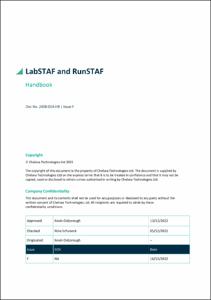| dc.contributor.author | Oxborough, Kevin | |
| dc.date.accessioned | 2022-12-16T20:37:29Z | |
| dc.date.available | 2021-03-25T20:26:32Z | |
| dc.date.available | 2021-07-09T21:39:28Z | |
| dc.date.available | 2021-08-31T11:57:13Z | |
| dc.date.available | 2022-12-16T20:37:29Z | |
| dc.date.issued | 2022 | |
| dc.identifier.citation | Oxborough, K. (2022) LabSTAF and RunSTAF Handbook: 2408-014-HB | Issue F. West Molesey, UK, Chelsea Technologies Ltd. 171pp. (Doc No. 2408-014-HB | Issue F). DOI: http://dx.doi.org/10.25607/OBP-1029.4 | en_US |
| dc.identifier.uri | https://repository.oceanbestpractices.org/handle/11329/1531.4 | |
| dc.identifier.uri | http://dx.doi.org/10.25607/OBP-1029.4 | |
| dc.description.abstract | This introductory section provides a brief overview of the development of LabSTAF and RunSTAF and future aims for the development of Single Turnover Active Fluorometry (STAF). It also includes a description of the major differences between LabSTAF and the previous generation of active fluorometers. A comprehensive overview of the acronyms and terms used within this document is provided within Glossary of terms.
1.1 The STAFES-APP and TechOceanS projects
LabSTAF is the first of a new generation of research-grade active fluorometers developed by Chelsea Technologies Ltd (CTL) in collaboration with The University of Southampton (UoS) and the National Oceanographic Centre, Southampton (NOCS) as part of the STAFES-APP project within the NERC-funded OCEANIDS programme (NE/P020844/1). Additional, ongoing funding for STAF development is being provided through the EU-funded Technologies for Ocean Sensing (TechOceanS) programme (Technologies for Ocean Sensing | TechOceanS Project | H2020 | CORDIS | European Commission (europa.eu)).
The STAFES-APP acronym expands to Single Turnover Active Fluorometry of Enclosed Samples – for Autonomous Phytoplankton Productivity. The overall aim of the project was to develop highly sensitive benchtop and deployable systems that can be used to improve our understanding of the global carbon cycle and aquatic ecosystem function.
Primary productivity by phytoplankton (PhytoPP) accounts for approximately half of the carbon fixed by photosynthesis on a planetary scale. It follows that measurement of PhytoPP on wide spatial and temporal scales has enormous potential for developing our understanding of ocean productivity and improving climate change models. Arguably the most important way in which this target can be achieved is through the validation and development of satellite remote sensing, which operates on the widest possible spatial scales, but which currently includes large errors for the estimation of PhytoPP. Historically, validation of remote sensing algorithms for the estimation of PhytoPP has relied on data from 14C tracer-based methods, including photosynthetron-based measurement of 14C-fixation as a function of incident light (Geider and Osborne, 1992; Sakshaug et al. 1997). Because this method cannot be applied on meaningful spatial or temporal scales, there is currently extreme undersampling of the oceanic environment for PhytoPP at acceptable levels of accuracy (e.g., Lee et al. 2015). A key target for the STAFES-APP project was to develop new, STAF-based methods for the assessment of PhytoPP that can be used on much wider spatial and temporal scales than 14C-fixation, at comparable levels of accuracy and precision. | en_US |
| dc.language.iso | en | en_US |
| dc.publisher | Chelsea Technologies Ltd. | en_US |
| dc.relation.ispartofseries | Doc No. 2408-014-HB | Issue F; | |
| dc.subject.other | Phytoplankton | en_US |
| dc.subject.other | Primary productivity | en_US |
| dc.subject.other | Fluorometer | en_US |
| dc.subject.other | Fluorometry | |
| dc.title | LabSTAF and RunSTAF Handbook 2408-014-HB Issue F. | en_US |
| dc.type | Report | en_US |
| dc.description.status | Published | en_US |
| dc.format.pages | 171pp. | en_US |
| dc.contributor.corpauthor | Chelsea Technologies Ltd. (CTL) | en_US |
| dc.description.refereed | Refereed | en_US |
| dc.publisher.place | West Molesey, UK | en_US |
| dc.subject.parameterDiscipline | Phytoplankton | en_US |
| dc.subject.instrumentType | Instrument Type Vocabulary::fluorometers | en_US |
| dc.description.currentstatus | Current | en_US |
| dc.description.sdg | 14.A | en_US |
| dc.description.eov | Phytoplankton biomass and diversity | en_US |
| dc.description.maturitylevel | Mature | en_US |
| dc.description.adoption | Multi-organisational | en_US |
| dc.description.methodologyType | Method | en_US |
| dc.description.methodologyType | Specification of criteria | en_US |
| dc.description.methodologyType | Reports with methodological relevance | en_US |
| obps.contact.contactname | Kevin Oxborough | |
| obps.contact.contactemail | koxborough@chelsea.co.uk | |
 Repository of community practices in Ocean Research, Applications and Data/Information Management
Repository of community practices in Ocean Research, Applications and Data/Information Management
